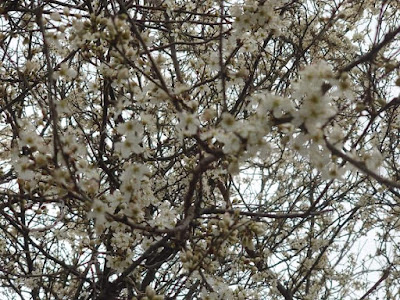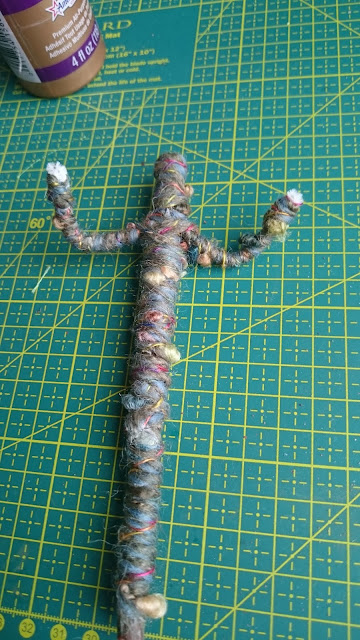Witchy Wednesday is back! Blackthorn.
 |
| My Blackthorn blossoming back in March 2023. |
I have Blackthorn growing in my little garden. In the spring it blooms with clusters of beautiful white flowers, once flowered the spring breezes cause the petals to detach covering my garden in a bed of white confetti! Then beautiful shoots of bright green leaves appear which darken as the summer advances. It then starts to produces dusty purple/blue tinged black sloes, which are ready to pick in the Autumn. Usually after the first frost. Which for those of you who like a tipple makes for a delightful gin! But any not taken for this purpose make good food for the birds. In fact the whole hedgerow makes a very valuable home for many species of insects, a place for birds to hide out, feed and shelter from the weather. Also because the sharp thorns it makes for a very secure barrier which is why farmers often used it to keep cattle away from crops and to help secure them in fields. The leaves then turn yellow and fall in the Autumn which leaves a dark skeletal almost lifeless body over the winter months exposing the sharp long thorns! I say almost lifeless as my hedgerow is home to various lichens and is still home to many insects during the winter months, often seeing elaborate embroidered webs decorating the branches on cold frosty mornings. Beautiful as they are you do not want to venture too close to a Blackthorn as you may stab yourself with a thorn! Blackthorn poisoning causes infection, swelling and joint pain and can result in sepsis if untreated! It was for this reason that early Christians used to believe blackthorn was the devil’s tree, later also known as Witches trees. Those who worshipped the devil would have their fingers pricked by its satanic spines as part of a ritual. Also that Witches used Blackthorns for deadly deeds attaching them to the ends of wands to jab at cattle and unlucky victims. Luckily nowadays if you do end up stabbed by a thorn, a risk of any gardener including for some people Rose thorns, a quick trip to the doctors or A&E plus treatment can easily sort these problems. Though painful not as life threatening as times gone by! But best to get any scratches or wounds acquired whilst gardening checked out if unsure.
Going back into history Blackthorn has many associations with magic and Witches. The Blackthorn wood has been reported in many articles and stories as being the wood most associated with Witches and magic folk. Even the story of Sleeping beauty Blackthorn forms a nearly impenetrable thorny bramble hiding the Princess from being rescued by a dashing Prince. Even the spinning wheel has a spike some researchers think that early stories it may have been a prick from a Blackthorn bush! In fact having a conversation with my Mum, who like me takes a great interest in folklore, flora and fauna, did suggest that maybe it's based on actual incidences involving thorns being found in sheeps wool. When sorting the wool for spinning a rogue thorn could have easily been caught in the sheeps wool pricking the finger of the poor unsuspecting spinner! Giving the poor spinner Blackthorn poisoning thus creating the beginnings of story of sleeping beauty.
The sharp thorns are often used in magic making. Witches often used them for piercing poppets. The thorns have also used to make Witches ladders! Many thorns would be tided to a length of string representing a rather spiky ladder this would be used as protection and for cursing and causing pain to others!
One story of Devonshire witches is beautiful described in this article.
http://winsham.blogspot.com/2018/07/the-heart-of-matter
Historically Blackthorn wood was and is still used for making walking sticks and Irish Shillelagh.
The dried fruits were also used for medicinal purposes and where used to treat bladder problems, kidney and stomach disorders, while the liquid from the boiled leaves was used as a mouthwash for sore throats, tonsillitis and laryngitis.
Sadly across Europe during the dark times of Witch trails Witches and Heretics where often burnt on pyres made from the branches of Blackthorn.
Nowadays, thank goodness, the Blackthorn is now beginning to be better understood and appreciated as an important part of the ecosystem and like myself being planted to encourage wildlife The berries or sloes produced are a welcomed bonus. Picked after the first frost, the frost makes the sloes sweeter, however you can pick and freeze them to simulate this process if you need to pick fruits sooner. The sloes are cooked down with sugar to make jam or if sieved clear jelly. There are lots of recipes online for Sloe jams. Plus can add sloes to gin, producing a fine tipple for the cold Winter months! ☺️
Make your own Sloe Gin using this simple BBC Recipe.
https://www.bbcgoodfood.com/recipes/sloe-gin
Interesting links about Witches, Blackthorn and woodlands.





